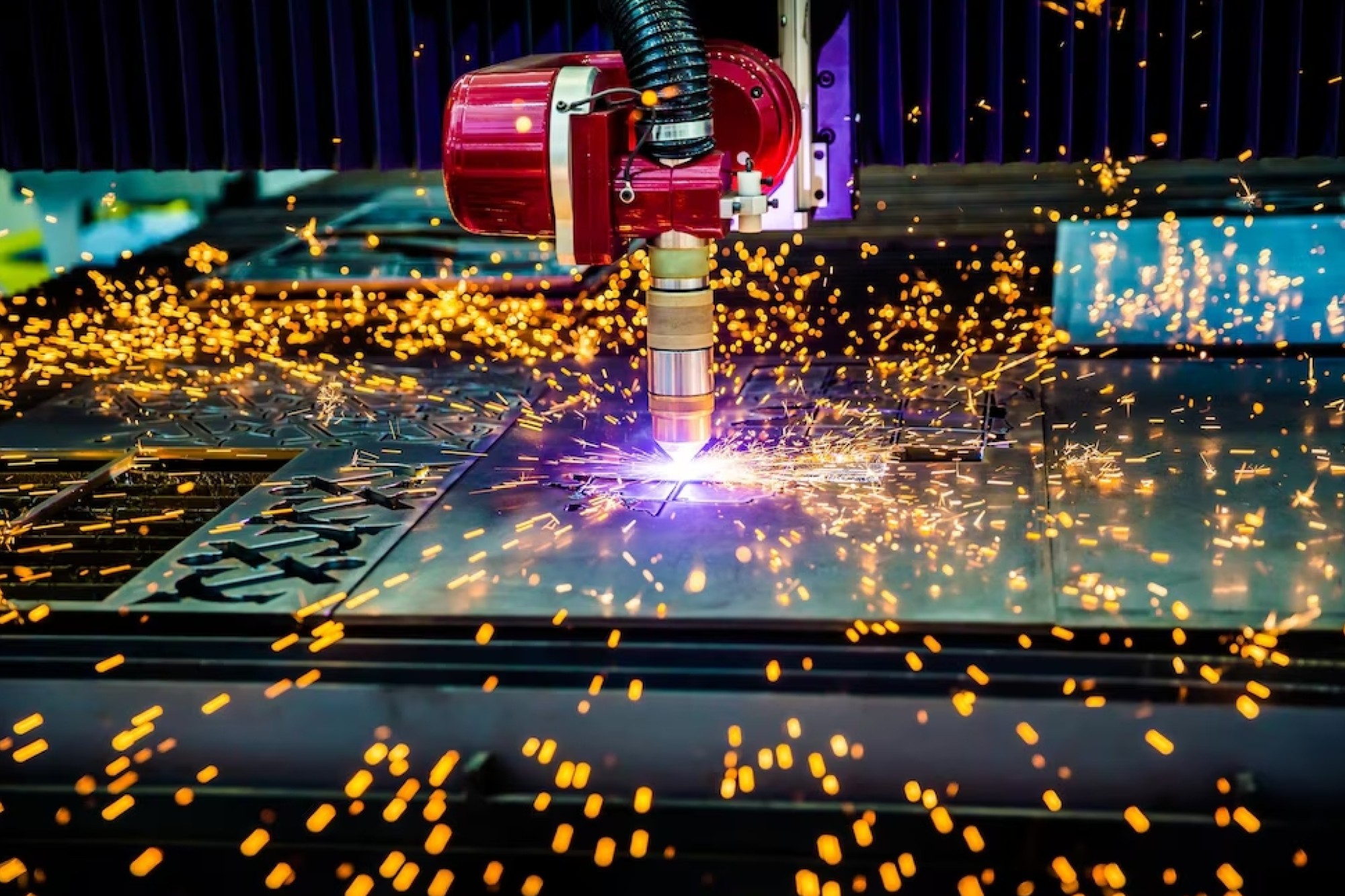Symphony of Cobots and Humans
By Staff Report July 31, 2024 5:32 pm IST
Automation is rapidly taking over the manufacturing sector with the changing phases of the industry. The advent of Industry 5.0 starts with the collaboration of cobots and humans, furnishing safety and productivity in the workplace. They are here not to replace humans but to remove the dullness and danger of the workforce.
Collaborative robots (cobots) are changing the work methods. They enhance simplicity, safety, and productivity, allowing humans to achieve more. Cobots have an infamous image of snatching jobs, but they are rather human-centred solutions. This unique collaboration can leverage The best human and robot capabilities. Cobots offer an efficient, adaptive, and scalable approach to automation. Unlike manual, inconsistent and unscalable workflows, cobots adapt to changing demands, making them productive and scalable in any setup. This leads to seamless transitions from manufacturing to market.
Traditional all-out automation is rigid and hard to change. Cobots effortlessly accomplish previously deemed impossible tasks by removing barriers to task automation. They are easy to deploy in any environment and accessible to line workers at all times.
Key features of cobots include engineering, electrics, interface, digital-twin technology, collaboration, perception, and no-code interaction. The no-code human-robot interaction is designed for line workers to automate tasks on the job. Workers can create and automate tasks without extensive thinking. Connecting with other machines and ecosystems has become error-free.
Collaborative robots are poised to enable future industries by making human-scale task automation accessible and efficient, ultimately improving production landscapes.
Balancing the cost of cobots
Making cobots work alongside humans and aligning them with existing processes is cost-consuming. Alka Sachdeva, Vice President of All India Council for Robotics & Automation, suggests, “To minimise these costs, assessing the compatibility of existing software and physical space with cobots is important. The integration process will not be cost-intensive, but it will require a thorough review of the current software to ensure proper integration.”
Training and awareness will promote the use of cobots in the workplace. Cobots can increase productivity by replacing human workers with their services, allowing employees to focus on more challenging tasks, and transferring repetitive tasks to the cobots. This awareness should be implemented at both employee and staff levels, with integration in infrastructure being one aspect and awareness being another.
Mindset to adapt cobots
Mindset is a major challenge. Hareesh Bommathanahalli, Manager—Applications, Svaya Robotics, shares a personal experience: Two decades ago, he was trying to sell robots in the US and faced a similar issue. He adds, “The prevalent mindset was a block because our approach emphasised the necessity of automation to avoid losing factories to China. The message was that without automating and improving productivity and quality, businesses would be unable to compete with China and risk losing their operations.”
In India, companies require prioritising quality assurance over the latest advanced technology to ensure production meets planned and promised levels, even during hard times or labour shortages. Companies can automate processes and ensure continuous production to stay ahead of the competition. Uninterrupted customer satisfaction will ensure lasting relations.
Companies should focus on long-term success rather than just comparing the cost of a machine to its salary over three years. In India, labour is cheap, making comparing robots with other technologies easy. However, the focus should be on quality, consistency, and staying ahead of the competition. This requires educating employees about the benefits of robots and creating an ecosystem within the organisation. By doing so, companies can train their employees and ensure their readiness to adopt new technologies and solutions, such as cobots.
Internet of Things
IoT (Internet of Things), or IoT (Internet of Robotic Things), is needed to prevent breakdowns in electromechanical machines like robots and cobots in factories. By predicting failures within 24 to 78 hours, preventive actions can be taken to safety.
Immediate notifications on smart devices are expected when critical parts or outfits are stopped, or energy is over. Hareesh adds that this allows quick action to ensure production as required. Managers handling the operations require production status every few minutes to maintain confidence in meeting daily, weekly, or monthly production targets. This information helps them with informed decisions regarding production.
The Internet of Things (IoT) is changing how factories operate, allowing unlimited access to analytic data and signals from machines. This technology allows for remote access to robots, cobots, smartphones, and other devices, enabling quick troubleshooting and analysis from anywhere in the world. However, businesses must be prepared to provide access to service providers’ production rates and internet access for remote analysis and support.
IoTs were restricted to offices and servers, fearing information theft in previous times. However, with the advent of IoT, machines are now communicating and interconnected over the internet, posing a challenge for management and employees. In the industry 3.0, machines worked in silos, allowing for a more secure environment. However, the IoT has made machines communicate and interact with each other, causing fear and uncertainty. To overcome these fears, businesses must embrace the IoT and its possibilities.
Another technology in this domain is Business Software Solutions (SAP), which can be integrated with manufacturing systems, allowing for control on a laptop or desktop. This allows for immediate monitoring of potential issues and proactive action. For example, a pre-alarm system can be implemented to address motor problems, allowing for immediate proactive solutions. However, these solutions are expensive in the Indian industry, making them necessary for adaptation on a larger scale.
MSMEs
MSMEs contribute extensively to the global supply chain and exports, exceeding 50 percent of the share. Their endowment to GDP is near 29%. To remain competitive, they must follow trends and automate their factories and production to improve cost-effectiveness and product quality. Improving manufacturing facilities with collaborative robots requires funding.
Darshana Thakkar, MSME Growth Expert, Founder & CEO -Transformation-The Strategy HUB, with extensive experience in dealing with MSMEs, shares that MSME owners often lack awareness of technology and government support and schemes. This is the major crunch for them. MSMEs should actively participate in community platforms to gather knowledge and information about technology and infrastructure improvement. The government supports automation and subsidies to MSMEs to upgrade and automate their factories, ensuring improved product quality.
MSMEs lack awareness about the latest market developments, technology, and packages. Despite numerous exhibitions and industry shows, decision-makers and manufacturers may not actively participate in these events, highlighting the need for increased awareness and participation.
Educated individuals do not prefer to work in black jobs like welding, cutting, grinding, and polishing. To address these issues, it is time to introduce robots or cobots. As technology becomes more affordable and available, MSMEs must take the first step in adopting these new tools.Anoop Singhal, Director – Sales & Operations (India), Chengdu CRP Robot Technology Co., Ltd., advises MSMEs to develop self-sufficiency and adapt to new technologies, as there will be a large demand-supply gap in skilled manpower in the future.
The government promotes indigenous products through various schemes and provides support to MSMEs. Alka adds, “They also support branding Indian products globally, ensuring they are integrated into the global market. This is to foster a sustainable and innovative economy.”
The annual budget prompted the industry by promoting technology implementation, encouraging industry towards automation, and supporting the creation of more effective products. It also supports startups, laying the ground for them to generate new ideas and address real-time problems in India. Science, technology, engineering, and mathematics (STEM) education is also actively pursued in colleges and universities, fostering the development of new technologies.
The Union Finance Minister announced on July 23 that as part of the nine priorities highlighted for the 2024 Union Budget, the Mudra loans limit will be enhanced to ₹20 lakhs from the current ₹10 lakhs for those who have availed of and successfully repaid loans previously taken under the Tarun category.
Many government institutes support industries in research, manufacturing setups, prototype development, and development. They also provide funds for startups.
MSMEs are collaborating with startups to develop new products and innovations to meet the growing demand. However, they lack the research, development and innovation skills and power.
Skilling and Academia
When interacting with industry experts regarding MSME adoption of technologies like robotic manipulators for manufacturing processes such as welding and printing, a common challenge is the lack of skilled personnel. Programming robots is easy, but understanding the logic and coordinate systems is challenging.
Manufacturers require skilled individuals who have been prepared from college, and their skill set covers mechanical engineering, design, kinematics, dynamics, control electronics, and electrical engineering. Manufacturers are creating a single platform for controlling and operating in the manufacturing sector in collaboration.
Dr Abhishek Singh, Professor of Automation and Robotics at Sandip Institute of Technology & Research Centre, shares that young students in his institution are unsure of which skills to focus on, such as learning, AI, ML, robot programming, electrical, or design. This is a universal issue. Students come from various engineering fields, and the confusion about which skills to adopt and focus on is a significant challenge.
======
Dr Abhishek Singh, Professor of Automation and Robotics, Sandip Institute of Technology & Research Centre
“Addressing the lack of skilled personnel for robotic manipulators requires a comprehensive approach in education and industry collaboration to bridge the gap.”
Alka Sachdeva, Vice President, All India Council for Robotics & Automation
“Integrating cobots with human workers requires assessing software and physical space compatibility to ensure effective, cost-efficient collaboration.”
Darshana Thakkar, MSME Growth Expert, Founder & CEO -Transformation-The Strategy HUB
“MSMEs need collaborative robots to automate factories and stay competitive, with government support playing a crucial role in this transition.”
Anoop Singhal, Director – Sales & Operations (India), Chengdu CRP Robot Technology Co., Ltd.
“Adopting cobots is essential for MSMEs to narrow the demand-supply gap in skilled manpower and enhance operational efficiency as technology becomes more affordable and accessible.”
Hareesh Bommathanahalli, Manager – Applications, Svaya Robotics.
“Companies must embrace the mindset that adopting cobots ensures consistent production quality, uninterrupted operations during uncertainties, and maintains a competitive edge through automation.”
Cookie Consent
We use cookies to personalize your experience. By continuing to visit this website you agree to our Terms & Conditions, Privacy Policy and Cookie Policy.















